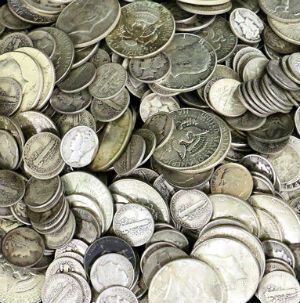Junk Silver Coins
Junk Silver Coins is a common term that refers to circulated coinage that was minted with silver. In the United States, coinage containing silver was in common circulation prior to 1965.
Silver bullion was used in the minting of all dimes, quarters, half-dollars and dollar coins before 1965. The silver in these coins is 90% pure silver. Nickel coins that were minted from 1942 to 1945 contained 35% silver content because the other metals were needed for the military efforts in World War II. The Kennedy Half-dollar coins minted between 1965 and 1969 were minted with 40% silver.
Together, these coins minted with 90%, 40% and 35% silver content are commonly referred to as junk silver because of their intrinsic value.
Why buy junk silver?
- Junk is real, genuine bullion. Each $1 face value of 90% junk silver contains .715 troy ounces of silver. Junk silver is commonly recognized as real silver. It is something that has been commonly accepted based on its intrinsic worth.
- Unlike other forms of bullion, Junk Silver is not commonly subjected to counterfeiting like other forms of silver. Junk silver does not have any numismatic value to collectors. It is collected as a store of value purely for the silver content. It is easy to buy junk silver.
- Junk silver is fractional silver and is easily dividable. It doesn’t carry the same premiums as other fractional silver bullion. Junk silver can easily be split up and sold or traded if it becomes necessary. It can make bartering and trading for goods and services much easier than other forms of silver and gold bullion because of its fractional nature.
- Junk silver has never been subject to government confiscation. In 1933 President Roosevelt ordered all gold coins held by citizens to be seized by the government. Those who failed to do so were subject to criminal penalties, fines and prison. When copper-clad coinage was introduced in 1965 many people hoarded the 90% silver coins.
- Junk silver is easy and convenient to store and doesn’t require any special holders, containers or method of storage. It can be stored like any coinage and many investors keep them in standard paper bank rolls.
- Junk silver carries a lower premium over spot price than other silver or gold bullion products. The price of junk silver is based purely on the silver content. With each $1 face value containing .715 troy ounces of silver.
- Most coin dealers, pawn shops or other places that trade in silver bullion will often have bags of junk silver available for sale. Bags containing $100 face value or $1000 face value are common. For making smaller buys as a way to store wealth, smaller increments can easily be found. Many dealers sell $5 face value rolls of silver dimes, or rolls of quarters containing $10 face value. It is easy to buy junk silver any time you have extra money.
- Junk silver with a lower silver content, such as war nickels (35% silver content) and Kennedy half-dollars from 1965 to 1969 (40% silver content) can often be bought for less than spot price. Some investors consider the lower silver content less desirable than other forms of bullion, which can lead to significantly lower premiums.
- Junk silver is easy to liquidate and sell. Just as junk silver is readily available and easily bought, it can also be sold just as easily. Any local coin shop, pawn shop will readily buy junk silver in the event you need to sell it.

